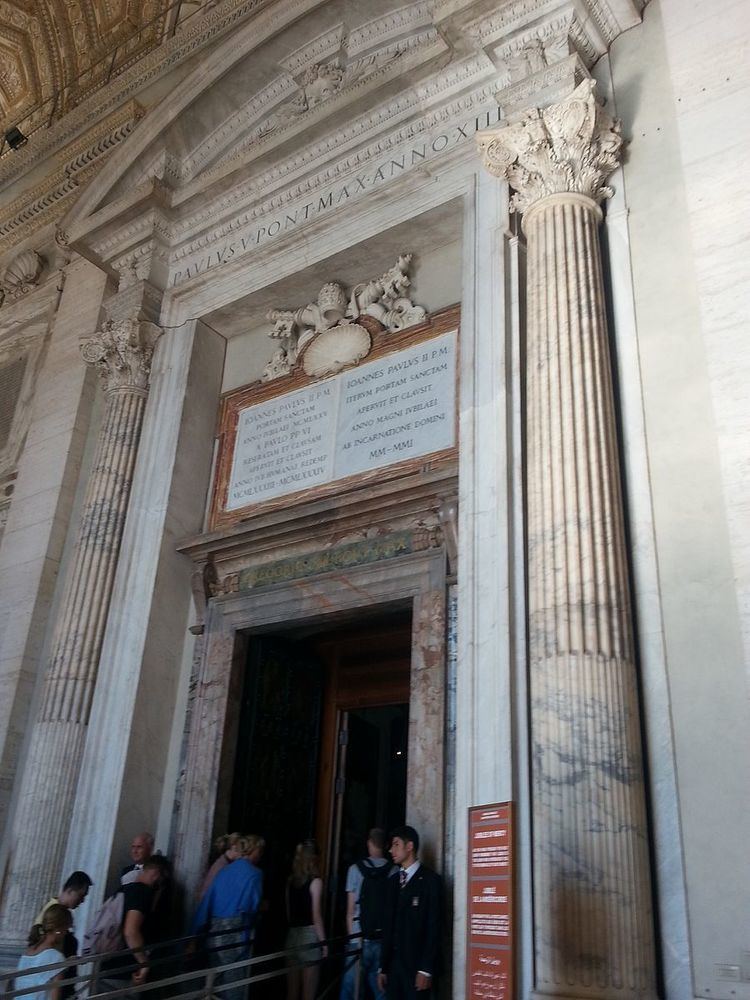Duration 349 days Type Jubilee | Location Worldwide Theme Mercy | |
 | ||
Native name Iubilaeum Extraordinarium Misericordiae Date 8 December 2015 (2015-12-08) – 20 November 2016 (2016-11-20) | ||
The Extraordinary Jubilee of Mercy (Latin: Iubilaeum Extraordinarium Misericordiae) was a Roman Catholic period of prayer held from 8 December 2015, the Feast of the Immaculate Conception, to 20 November 2016, the Feast of Christ the King. Like previous jubilees, it was seen by the Church as a period for remission of sins and universal pardon focusing particularly on God's forgiveness and mercy. It was an extraordinary Jubilee because it had not been predetermined long before; ordinary jubilees are usually celebrated every 25 years. The 2016 Jubilee was first announced by Pope Francis on 13 March 2015. It was declared in the pope's April 2015 papal bull of indiction, Misericordiae Vultus (Latin: "The Face of Mercy"). It is the 27th holy year in history, following the ordinary 2000 Jubilee during John Paul II's papacy. The opening day was also the 50th anniversary of the closing of the Second Vatican Council.
Contents
Francis wished for the Jubilee to be celebrated not only in Rome but all around the world; for the first time holy doors are open in single dioceses, either in the cathedral or in historical churches. The first holy door was opened by Pope Francis in Bangui on 29 November 2015, during a tour of East Africa. It officially ended on November 20, 2016 with the closing of the Holy Door of Saint Peter's Basilica which was open since the Holy Year began the previous December.
Papal bull
The Jubilee of Mercy was formally declared through the papal bull Misericordiæ Vultus, issued on 11 April 2015, which emphasizes the importance of mercy and the need to 'gaze' on it; the bull also recalls the need for the Church to be more open, keeping alive the spirit of the Second Vatican Council.
The holy doors of the major basilicas of Rome (including the Great Door of St. Peter's) were opened, and special 'Doors of Mercy' were opened at cathedrals and other major churches around the world. The opening of the holy door at St. Peter's was the first time two popes were present, as Pontiff Emeritus Benedict attended at Pope Francis' invitation.
By passing through the holy doors, the faithful can earn indulgences after fulfilling the usual conditions of prayer for the pope's intentions, confession, and detachment from sin, and communion. During Lent of that year, special 24-hour penance services will be celebrated, and during the year, special qualified and experienced priests called 'Missionaries of Mercy' will be available in every diocese to forgive even severe, special-case sins normally reserved to the Holy See's Apostolic Penitentiary.
In the bull, Pope Francis states about the opening of the holy door, "the Holy Door will become a Door of Mercy through which anyone who enters will experience the love of God who consoles, pardons, and instils hope".
Concessions
It was announced that all priests (during the Jubilee year – ending 20 November 2016), will be allowed in the Sacrament of Penance to remove censures for abortion, which outside North America is reserved to bishops and certain priests who are given such mandate by their bishop.
By the same letter, Pope Francis also granted permission for priests of the Society of Saint Pius X to validly confer absolution, while under normal circumstances they do not possess the jurisdiction needed to confer this sacrament.
Logo and hymn
The official logo, designed by Father Marko I. Rupnik, shows Jesus, personification of Mercy, carrying on his shoulders a "lost man", emphasizing how deep the Savior touches humanity; his eyes are merged with those of the carried man. The background is filled by three concentric ovals, with lighter colors outwards, meaning that Jesus is carrying the man out of the darkness of sin. On one side the image is also joined by the official motto: Misericordes Sicut Pater (Merciful Like the Father), derived from Luke 6:36, which stands as an invitation to follow the example of the Father by loving and forgiving without limits.
The official hymn, with most verses derived from the Gospels, First Corinthians and Psalms, was written by Eugenio Costa, S.J., with original music composed by Paul Inwood.
Main events
The following main events and days of celebration for specific categories of faithfuls are scheduled:
Apostolic letter
Misericordia et misera is an ecclesiastical letter authored by Pope Francis and scheduled for release on 21 November 2016 following the conclusion of the Extraordinary Jubilee of Mercy. He signed it in a public ceremony on 20 November and presented copies to representatives chosen to represent the universal audience for his message: a Philippine cardinal, Luis Antonio Tagle, of Manila, and a Scottish archbishop, Leo Cushley, two missionary priests from Brazil and the Democratic Republic of the Congo, a Roman deacon and his family, two women religious from South Korea and Mexico, three generations of a U.S. family, an engaged couple, religious instructors, and two people representing the disabled and the sick.
The title of the document references Saint Augustine's commentary on Jesus and the woman taken in adultery in the Gospel of John. After Jesus challenges her accusers and they withdraw, Augustine says that only "misera et misericordia" (misery and mercy) remain. Pope Francis reverses the two terms Augustine used.
The document was released at a press conference hosted by Rino Fisichella, President of the Pontifical Council for the Promotion of the New Evangelisation.
